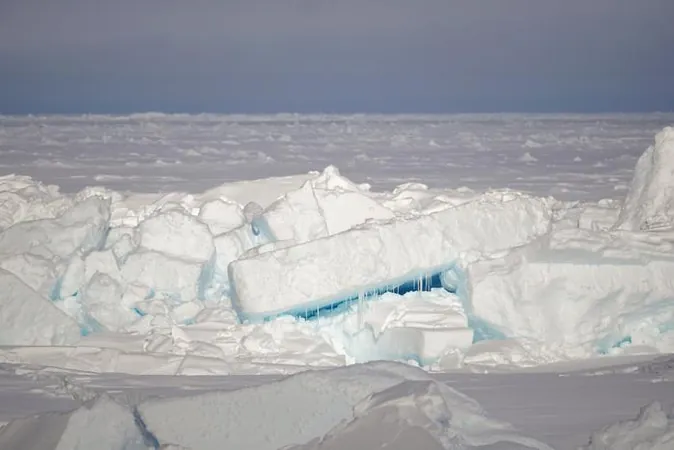
Melting Away: The Stark Decline of Arctic Pressure Ridges Amidst Climate Change
2025-01-08
Author: Jacob
The Arctic is facing a silent crisis as the relentless assault of climate change leads to the alarming melting of multiyear ice. This alarming trend has resulted in a significant decrease in the frequency and size of Arctic pressure ridges—vital structures that play a crucial role in the unique Arctic ecosystem.
Pressure ridges form when ice floes come into contact and stack on top of each other, creating formidable obstacles that have implications for shipping routes and marine life. As these features of Arctic sea ice are diminishing, new research from the Alfred Wegener Institute (AWI) sheds light on the dramatic changes occurring in this icy frontier.
For the past thirty years, satellite data have documented the relentless decline of summer sea ice. The research reveals that not only is the area of ice shrinking, but the remaining ice floes are also becoming thinner and moving with increasing speed. Until now, the impact on pressure ridges had not been thoroughly understood as reliable monitoring from space has only been feasible in recent years.
The Crucial Role of Arctic Pressure Ridges
These pressure ridges are integral to the Arctic environment. Formed under lateral stress, their distinctive structure includes an above-water part known as the "sail," which typically measures between one to two meters in height, while the submerged "keel" can extend downward as deep as 30 meters. This height difference creates a significant barrier for vessels navigating these waters.
Pressure ridges enhance the energy dynamics and nutrient flow in their ecosystems. They provide essential habitats for Arctic wildlife, including polar bears, which utilize them for shelter and birthing. Additionally, these structures mitigate the effects of climate change by facilitating nutrient mixing in underlying waters, thus supporting diverse ice-associated life forms.
Research Findings: Declining Frequency and Size
Remarkable findings from AWI researchers reveal a concerning trend: the frequency of pressure ridges in critical regions like north of Greenland and the Fram Strait has decreased by 12.2% per decade, with their average height diminishing by 5%. In areas such as the Lincoln Sea, where older ice aggregates, the data indicates an even sharper decline—14.9% in frequency and 10.4% in height per decade.
Dr. Thomas Krumpen, lead author and sea-ice expert at AWI, emphasized that as the multiyear ice dwindles, there's a shift towards younger, thinner ice that easily deforms to create new ridges. Despite this potential for new formation, the overall loss of older ice is dominating trends, leading to a net reduction in pressure ridges.
Implications for the Arctic Ecosystem
The research team developed a metric that combines all observational data to assess broader changes across the Arctic. However, understanding the direct impacts of the decline in pressure ridges on the ecosystem requires advanced modeling that accounts for the age and condition of sea ice.
Dr. Luisa von Albedyll from AWI pointed out that the shrinkage of ridge sails should ideally slow the drifting of ice. Yet, paradoxically, other factors such as stronger ocean currents or a smoother underside of the ice, exacerbated by melting, may be speeding up their drift.
The implications are alarming. A growing percentage of pressure ridges fail to survive their first summer, threatening the delicate balance of the Arctic ecosystem.
What's Next? Future Research Endeavors
To delve deeper into these climatic changes, next summer will witness an expedition aboard the research vessel Polarstern. This mission aims to explore the biological and biogeochemical distinctions between ice floes and pressure ridges of varying ages and origins.
The integration of extensive aerial survey flights with this research will enhance insights into how melting ice interacts with climate and ecosystems, shedding light on the interconnectedness of the Arctic ecosystem battling against the effects of climate change.
In conclusion, as alarming changes unfold in the Arctic, it becomes increasingly crucial for researchers to share data and insights. The future of these iconic pressure ridges—and the Arctic ecosystem—depends on our understanding and response to the unyielding impacts of climate change.









 Brasil (PT)
Brasil (PT)
 Canada (EN)
Canada (EN)
 Chile (ES)
Chile (ES)
 Česko (CS)
Česko (CS)
 대한민국 (KO)
대한민국 (KO)
 España (ES)
España (ES)
 France (FR)
France (FR)
 Hong Kong (EN)
Hong Kong (EN)
 Italia (IT)
Italia (IT)
 日本 (JA)
日本 (JA)
 Magyarország (HU)
Magyarország (HU)
 Norge (NO)
Norge (NO)
 Polska (PL)
Polska (PL)
 Schweiz (DE)
Schweiz (DE)
 Singapore (EN)
Singapore (EN)
 Sverige (SV)
Sverige (SV)
 Suomi (FI)
Suomi (FI)
 Türkiye (TR)
Türkiye (TR)
 الإمارات العربية المتحدة (AR)
الإمارات العربية المتحدة (AR)